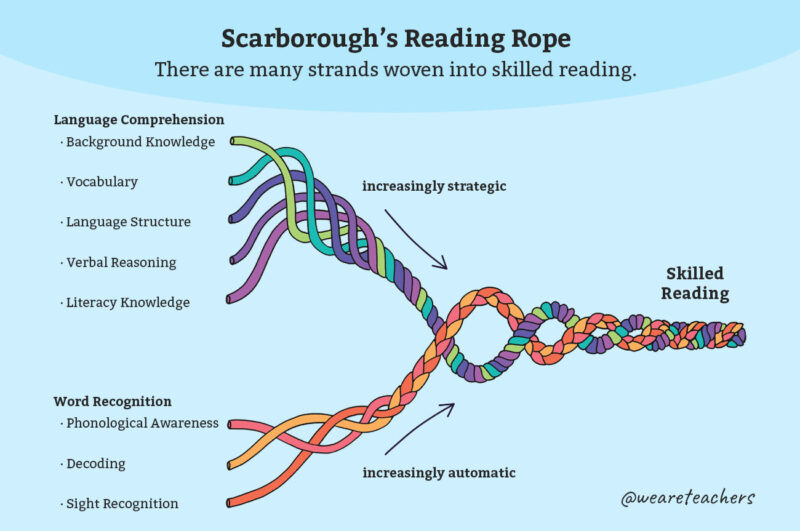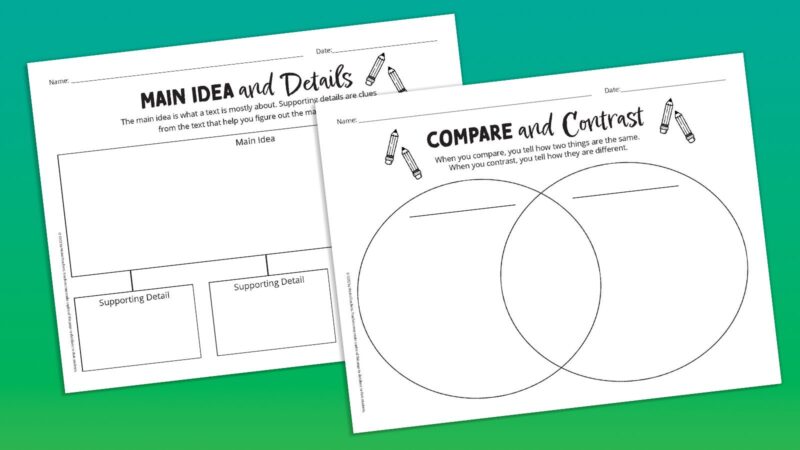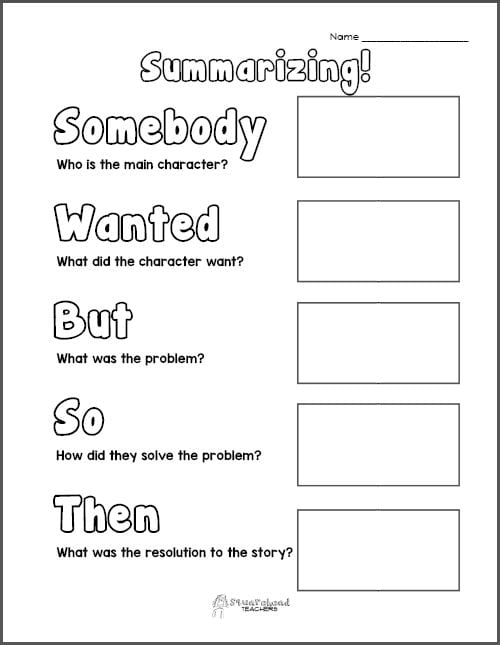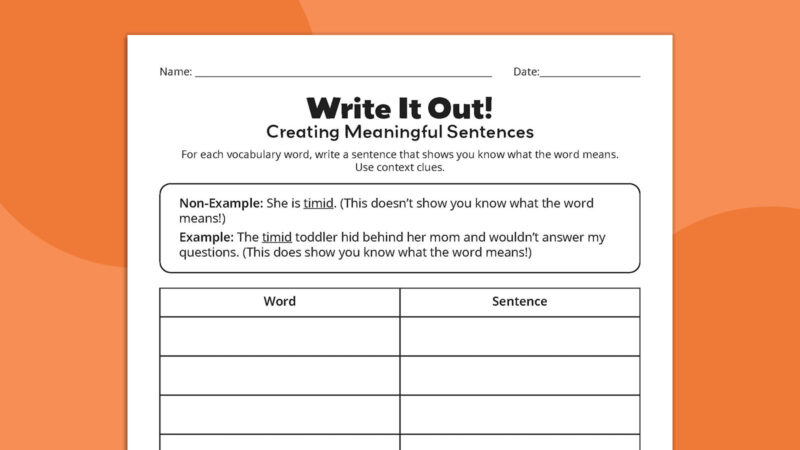14 Powerful Reading Comprehension Strategies To Teach Students

Comprehension is the goal of reading. If students don’t understand what they read, well, reading is a meaningless activity. The good news: Reading comprehension can be taught, practiced, and mastered. As students become readers, you can teach strategies that students can learn and add to their toolbox.
What is reading comprehension?
Think about reading comprehension as a combination of skills. Students need to get the words off the page (fluency, word reading) and understand the language they are reading (language structure, knowledge, vocabulary, and reasoning). If a student does not have strong language comprehension skills in particular, they won’t understand what they read, even if their fluency and word reading is strong. Reading comprehension strategies focus on building students’ language comprehension and teach them how to tackle text when they don’t understand.

Scarborough’s Reading Rope is a way to visualize the skills that go into reading. The top five skills (background knowledge, vocabulary, language structure, verbal reasoning, and literacy knowledge) become more strategic over time as students learn how to apply strategies to different kinds of text. The bottom three skills (phonological awareness, decoding, and sight recognition) become more automatic as students master each skill.
Learn more: What Is Reading Comprehension?
Reading Comprehension Strategies
Here are our favorite reading comprehension strategies to help students develop and strengthen their reading comprehension.
1. Establish a purpose for reading
Reading comprehension starts before students open a book. Teach students to set a purpose for reading, weather that’s to enjoy a story or to answer a specific question. Having a purpose helps students focus on the most important information and sift out less important details.
2. Graphic organizers

Graphic organizers are a tried-and-true strategy. Students can use an organizer that aligns with the text they are reading. So, if they are reading a nonfiction article about an event, they may use a sequencing graphic organizer. If they are reading a section of a textbook, they may use a main idea and detail graphic organizer. The key is to teach students the types of graphic organizers that exist, the type of text each is used for, and how to use each one during reading.
Try it: Free Printable Reading Comprehension Graphic Organizers
3. Activate background knowledge

The more knowledge students have about a topic, the more they will understand. Prior knowledge includes information about a topic (sharks, weather) and information about how text works (anticipating that the first chapter of a novel will include information about the main character, setting, and problem). It’s not about teaching students all the facts, but teaching them how to reflect on what they know before they read. If they know a lot, they can dive in. If they don’t know much, they may want to preview the text for key words and images to build some background knowledge.
Learn more: What Is Background Knowledge?
4. Predict and infer

Making predictions or inferences involves combining multiple pieces of information to either predict or think about what will happen next, or to infer meaning that’s not stated in the text. Teach students to make predictions with a graphic organizer that prompts them to combine information from the text with their own ideas and thinking to predict or infer.
Try it: Free Printables: Predictions and Inferences
5. Ask and answer questions
Questioning is another proven reading comprehension strategy. When we can ask and answer questions as we read, it means we’re thinking about what we read. Teach students how to question by modeling with a think-aloud. Then, have students jot questions on sticky notes as they read and return to their questions to answer them as they read to build comprehension.
Learn more: Improving Reading Comprehension With Think-Alouds
6. Summarizing

When students can summarize text, they’ve grasped the main points and are able to retell what they learned. One great way to summarize is a book talk, where students summarize a book and try to convince others to read it (or not).
Another way to support summarizing for fiction text is with a graphic organizer that helps them retell: Somebody … wanted … but … so … then. For nonfiction, use a main idea and details graphic organizer.
Try it: Free Summarizing Graphic Organizers
7. Visualization
When authors write, they create images and scenes. Even in nonfiction, authors create scenes that we can imagine. Being able to visualize makes reading more interesting (like watching a movie in your head). Teach students to visualize by starting small. Read sentences and have them draw what they see. Then, expand this strategy as you engage students in visualizing scenes.
8. Metacognition
Metacognition means understanding our own thought processes. In reading, this means knowing if we understand what we’re reading, and how to stop and review if we aren’t understanding. Teach students to notice what they’re thinking when they read. Are they asking questions? What do they wonder? Which parts make them laugh? Are there any big surprises in what they read?
Learn more: What Is Metacognition?
9. Monitoring comprehension
Monitoring comprehension is the process readers use to determine if they understand what they are reading. Have students stop at the end of a paragraph and page and think What did I read? If they can summarize what they read, they go on. If they cannot, they use a fix-up strategy, like rereading the section or looking up vocabulary words.
10. Making connections
When students make connections, they’re building knowledge. Model and teach three main types of connections:
- Text to self: How does the text connect with your life or experiences?
- Text to text: How does this part of the text connect to what you read in this text or what you have read in other texts?
- Text to world: How does what you’re reading connect with what you know?
Learn more: Using hexagonal thinking
11. Determining importance
Sometimes students get overwhelmed by the amount of information they’re reading. Teach them to calculate the importance of details they read. Students highlight or record the details they read, and then put each through a “funnel” where they think about whether or not it is actually important. Only the most important details make it through the funnel.
12. Recognizing story structure

Stories have a predictable structure that students can use to comprehend them. Knowing that stories start by explaining the character, setting, and problem can help students anticipate looking for this important information as they get into a story. And knowing that the story will hit a climax before the problem resolves also helps students anticipate the end of the story. Use story map graphic organizers to help improve students’ understanding of narrative by focusing on important information while they’re reading.
Try it: Free Story Map Printable Worksheets
13. Retelling
Retelling is a strategy that involves telling the most important information. Have students do a five-finger retell. They hold their hand up and point to each finger as they explain the characters, setting, events one, two, and three, and the conclusion. Students point to their palm and share an opinion of the story or how the story made them feel. Using this prompt reminds students to include the main aspects of a story.
14. Build vocabulary

The more words a student knows, the more words they can learn, and the deeper they understand what they read. And the more times a student engages with a word, the more likely they are to actually remember and use the word. Teach words using visuals and activities, like creating sentences with vocabulary. And teach students how to engage with words in text. For example, practice reading “around” a word to define it—when students read on their own, they can use the same strategy when they’re stuck on a word.
Try it: Free Printable Vocabulary Worksheet Bundle
Reading about reading? Check out What Is the Science of Reading?
And for more articles like this, be sure to subscribe to our newsletters!

Source link




